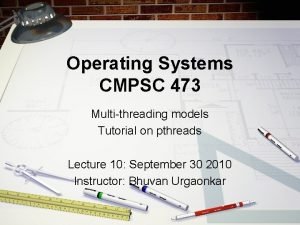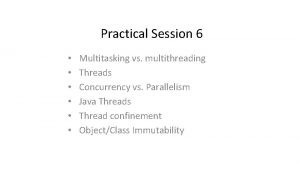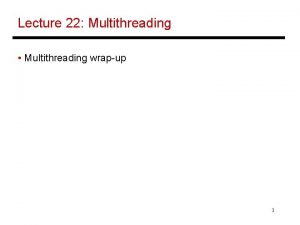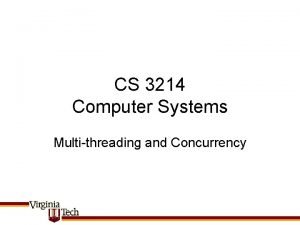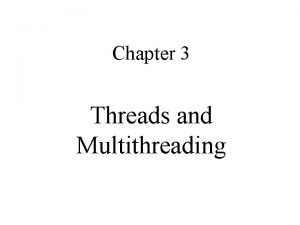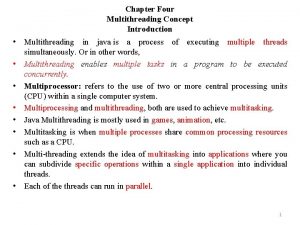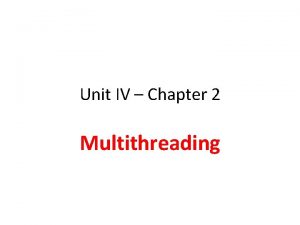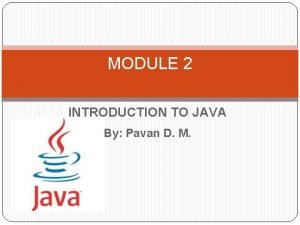MODULE 4 MULTITHREADING PROGRAMMING PAVAN D M Multithreading














































- Slides: 46

MODULE 4 MULTITHREADING PROGRAMMING PAVAN D. M.

Multithreading � Java provides built-in support for multithreaded programming. � A multithreaded program contains two or more parts that can run concurrently. Each part of such a program is called a thread, and each thread defines a separate path of execution. � Thus, multithreading is a specialized form of multitasking. � You are almost certainly acquainted with multitasking, because it is supported by virtually all modern operating systems. � There are two distinct types of multitasking. MULTITASKING Process-based Thread-based It is important to understand the difference between the two.

Contd… � For most readers, process-based multitasking is the more familiar form. � A process is, in essence, a program that is executing. Thus, process-based multitasking is the feature that allows your computer to run two or more programs concurrently. � For example, process-based multitasking enables you to run the Java compiler at the same time that you are using a text editor. � In process based multitasking, a program is the smallest unit of code that can be dispatched by the scheduler. � In a thread-based multitasking environment, the thread is the smallest unit of dispatchable code. This means that a single program can perform two or more tasks simultaneously. � For instance, a text editor can format text at the same time that it is printing, as long as these two actions are being performed by two separate threads. � Thus, process-based multitasking deals with the “big picture, ” and thread-based multitasking handles the details. � Multitasking threads require less overhead than multitasking processes. Processes are heavyweight tasks that require their own separate address spaces.

Contd… � Interprocess communication is expensive and limited. Context switching from one process to another is also costly. � Threads, on the other hand, are lightweight. They share the same address space and cooperatively share the same heavyweight process. � Interthread communication is inexpensive, and context switching from one thread to the next is low cost. � While Java programs make use of process-based multitasking environments, processbased multitasking is not under the control of Java. However, multithreaded multitasking is under the control. � Multithreading enables you to write very efficient programs that make maximum use of the CPU, because idle time can be kept to a minimum. � This is especially important for the interactive, networked environment in which Java operates, because idle time is common. � For example, the transmission rate of data over a network is much slower than the rate at which the computer can process it. � Even local file system resources are read and written at a much slower pace than they can be processed by the CPU.

Contd… � In a single-threaded environment, your program has to wait for each of these tasks to finish before it can proceed to the next one—even though the CPU is sitting idle most of the time. � Multithreading lets you gain access to this idle time and put it to good use.

The Java Thread Model � The Java run-time system depends on threads for many things, and all the class libraries are designed with multithreading in mind. � In fact, Java uses threads to enable the entire environment to be asynchronous. � This helps reduce inefficiency by preventing the waste of CPU cycles. � The value of a multithreaded environment is best understood in contrast to its counterpart. Single-threaded systems use an approach called an event loop with polling. � In this model, a single thread of control runs in an infinite loop, polling a single event queue to decide what to do next. � Once this polling mechanism returns with, say, a signal that a network file is ready to be read, then the event loop dispatches control to the appropriate event handler. � Until this event handler returns, nothing else can happen in the system. This wastes CPU time. � It can also result in one part of a program dominating the system and preventing any other events from being processed. � In general, in a singled-threaded environment, when a thread blocks (that is, suspends execution) because it is waiting for some resource, the entire program stops running.

Contd… � The benefit of Java’s multithreading is that the main loop/polling mechanism is eliminated. � One thread can pause without stopping other parts of your program. � For example, the idle time created when a threads data from a network or waits for user input can be utilized elsewhere. � Multithreading allows animation loops to sleep for a second between each frame without causing the whole system to pause. When a thread blocks in a Java program, only the single thread that is blocked pauses. All other threads continue to run. �Threads exist in several states. � A thread can be running. � It can be ready to run as soon as it gets CPU time. A running thread can be suspended, which temporarily suspends its activity. � A suspended thread can then be resumed, allowing it to pick up where it left off. A thread can be blocked when waiting for a resource. � At any time, a thread can be terminated, which halts its execution immediately. Once terminated, a thread cannot be resumed.

Thread Priorities � Java assigns to each thread a priority that determines how that thread should be treated with respect to the others. � Thread priorities are integers that specify the relative priority of one thread to another. � As an absolute value, a priority is meaningless; a higher-priority thread doesn’t run any faster than a lower-priority thread if it is the only thread running. � Instead, a thread’s priority is used to decide when to switch from one running thread to the next. � This is called a context switch. � The rules that determine when a context switch takes place are simple: � 1) A thread can voluntarily relinquish control : This is done by explicitly yielding, sleeping, or blocking on pending I/O. In this scenario, all other threads are examined, and the highest-priority thread that is ready to run is given the CPU. � 2) A thread can be preempted by a higher-priority thread : In this case, a lowerpriority thread that does not yield the processor is simply preempted—no matter what it is doing— by a higher-priority thread. This is called preemptive multitasking

Contd… � In cases where two threads with the same priority are competing for CPU cycles, the situation is a bit complicated. � For operating systems such as Windows, threads of equal priority are time-sliced automatically in round-robin fashion. � For other types of operating systems, threads of equal priority must voluntarily yield control to their peers.

Synchronization � Because multithreading introduces an asynchronous behavior to your programs, there must be a way for you to enforce synchronicity when you need it. � For example, if you want two threads to communicate and share a complicated data structure, such as a linked list, you need some way to ensure that they don’t conflict with each other. � That is, you must prevent one thread from writing data while another thread is in the middle of reading it. � For this purpose, Java implements an elegant twist on an age-old model of interprocess synchronization: the monitor. � The monitor is a control mechanism first defined by C. A. R. Hoare. You can think of a monitor as a very small box that can hold only one thread. � Once a thread enters a monitor, all other threads must wait until that thread exits the monitor. In this way, a monitor can be used to protect a shared asset from being manipulated by more than one thread at a time. � Most multithreaded systems expose monitors as objects that your program must explicitly acquire and manipulate. Java provides a cleaner solution. � There is no class “Monitor”; instead, each object has its own implicit monitor that is automatically entered when one of the object’s synchronized methods is called.

Contd…. � Once a thread is inside a synchronized method, no other thread can call any other synchronized method on the same object. � This enables you to write very clear and concise multithreaded code, because synchronization support is built into the language. �Messaging : After you divide your program into separate threads, you need to define how they will communicate with each other. � When programming with most other languages, you must depend on the operating system to establish communication between threads. This, of course, adds overhead. � By contrast, Java provides a clean, low-cost way for two or more threads to talk to each other, via calls to predefined methods that all objects have. � Java’s messaging system allows a thread to enter a synchronized method on an object, and then wait there until some other thread explicitly notifies it to come out.

The Thread Class and the Runnable Interface � Java’s multithreading system is built upon the Thread class, its methods, and its companion interface, Runnable. � Thread encapsulates a thread of execution. � Since you can’t directly refer to the ethereal state of a running thread, you will deal with it through its proxy, the Thread instance that spawned it. � To create a new thread, your program will either extend Thread or implement the Runnable interface. � The Thread class defines several methods that help manage threads.

The Main Thread � When a Java program starts up, one thread begins running immediately. � This is usually called the main thread of your program, because it is the one that is executed when your program begins. � The main thread is important for two reasons: • It is the thread from which other “child” threads will be spawned. • Often, it must be the last thread to finish execution because it performs various shutdown actions. � Although the main thread is created automatically when your program is started, it can be controlled through a Thread object. � To do so, you must obtain a reference to it by calling the method current. Thread( ), which is a public static member of Thread. � Its general form is shown here: static Thread current. Thread( ) � This method returns a reference to the thread in which it is called. Once you have a reference to the main thread, you can control it just like any other thread.

Example // Controlling the main Thread. class Current. Thread. Demo { public static void main(String args[ ]) { Thread t = Thread. current. Thread( ); System. out. println("Current thread: " + t); // change the name of the thread t. set. Name("My Thread"); System. out. println("After name change: " + t); try { for(int n = 5; n > 0; n--) { System. out. println(n); Thread. sleep(1000); } } catch (Interrupted. Exception e) { System. out. println("Main thread interrupted"); } } } In this program, a reference to the current thread (the main thread, in this case) is obtained by calling current. Thread( ), and this reference is stored in the local variable t.

Contd…. � In this program, a reference to the current thread (the main thread, in this case) is obtained by calling current. Thread( ), and this reference is stored in the local variable t. � The program then calls set. Name( ) to change the internal name of the thread. Information about the thread is then redisplayed. � Next, a loop counts down from five, pausing one second between each line. The pause is accomplished by the sleep( ) method. � The argument to sleep( ) specifies the delay period in milliseconds. Notice the try/catch block around this loop. � The sleep( ) method in Thread might throw an Interrupted. Exception. � This would happen if some other thread wanted to interrupt this sleeping one. This example just prints a message if it gets interrupted. � In a real program, you would need to handle this differently. Here is the output generated by this program: Current thread: Thread[main, 5, main] After name change: Thread[My Thread, 5, main] 5 4 3 2 1

Contd… � Notice the output produced when t is used as an argument to println( ). This displays, in order: the name of the Its priority, and the name of its group. � By default, the name of the main thread is main. Its priority is 5, which is the default value, and main is also the name of the group of threads to which this thread belongs. � A thread group is a data structure that controls the state of a collection of threads as a whole. � After the name of the thread is changed, t is again output. This time, the new name of the thread is displayed. � Let’s look more closely at the methods defined by Thread that are used in the program. The sleep( ) method causes the thread from which it is called to suspend execution for the specified period of milliseconds. static void sleep(long milliseconds) throws Interrupted. Exception � The number of milliseconds to suspend is specified in milliseconds. This method may throw an Interrupted. Exception. � The sleep( ) method has a second form, shown next, which allows you to specify the period in terms of milliseconds and nanoseconds:

Contd… � General Form static void sleep(long milliseconds, int nanoseconds) throws Interrupted. Exception � This second form is useful only in environments that allow timing periods as short as nanoseconds. � As the preceding program shows, you can set the name of a thread by using set. Name( ). � You can obtain the name of a thread by calling get. Name( ) � These methods are members of the Thread class and are declared like this: final void set. Name(String thread. Name) final String get. Name( )

Creating a Thread � In the most general sense, you create a thread by instantiating an object of type Thread. � Java defines two ways in which this can be accomplished: • You can implement the Runnable interface. • You can extend the Thread class, itself. 1) Implementing Runnable : The easiest way to create a thread is to create a class that implements the Runnable interface. � Runnable abstracts a unit of executable code. � You can construct a thread on any object that implements Runnable. � To implement Runnable, a class need only implement a single method called run(), which is declared like this: public void run( ) Inside run( ), you will define the code that constitutes the new thread. � It is important to understand that run( ) can call other methods, use other classes, and declare variables, just like the main thread can.

Contd…. � The only difference is that run( ) establishes the entry point for another, concurrent thread of execution within your program. This thread will end when run( ) returns. � After you create a class that implements Runnable, you will instantiate an object of type Thread from within that class. � Thread defines several constructors. The one that we will use is shown here: Thread(Runnable thread. Ob, String thread. Name) � In this constructor, thread. Ob is an instance of a class that implements the Runnable interface. This defines where execution of the thread will begin. The name of the new thread is specified by thread. Name. � After the new thread is created, it will not start running until you call its start( ) method, which is declared within Thread. � In essence, start( ) executes a call to run( ). The start( ) method is shown here: void start( )

Programs // Create a second thread. class New. Thread implements Runnable { Thread t; New. Thread( ) { // Create a new, second thread t = new Thread(this, "Demo Thread"); System. out. println("Child thread: " + t); t. start(); // Start the thread } // This is the entry point for the second thread. public void run( ) { try { for(int i = 5; i > 0; i--) { System. out. println("Child Thread: " + i); Thread. sleep(500); } } catch (Interrupted. Exception e) { System. out. println("Child interrupted. "); } System. out. println("Exiting child thread. "); } } class Thread. Demo { public static void main(String args[]) { new New. Thread( ); // create a new thread try { for(int i = 5; i > 0; i--) { System. out. println("Main Thread: " + i); Thread. sleep(1000); } } catch (Interrupted. Exception e) {System. out. println("Main thread interrupted. "); } System. out. println("Main thread exiting. "); } }

Contd… � Inside New. Thread’s constructor, a new Thread object is created by the following statement: t = new Thread(this, "Demo Thread"); � Passing this as the first argument indicates that you want the new thread to call the run( ) method on this object. � Next, start( ) is called, which starts the thread of execution beginning at the run( ) method. � This causes the child thread’s for loop to begin. After calling start( ), New. Thread’s constructor returns to main( ). � When the main thread resumes, it enters its for loop. Both threads continue running, sharing the CPU, until their loops finish. � In fact, for some older JVMs, if the main thread finishes before a child thread has completed, then the Java run-time system may “hang. ” � The preceding program ensures that the main thread finishes last, because the main thread sleeps for 1, 000 milliseconds between iterations, but the child thread sleeps for only 500 milliseconds. � This causes the child thread to terminate earlier than the main thread.

Contd… � 2) Extending Thread: The second way to create a thread is to create a new class that extends Thread, and then to create an instance of that class. � The extending class must override the run( ) method, which is the entry point for the new thread. � It must also call start( ) to begin execution of the new thread. Here is the preceding program rewritten to extend Thread: PROGRAM � This program generates the same output as the preceding version. As you can see, the child thread is created by instantiating an object of New. Thread, which is derived from Thread. � Notice the call to super( ) inside New. Thread. This invokes the following form of the Thread constructor: public Thread(String thread. Name) � Here, thread. Name specifies the name of the thread.

Choosing an Approach � At this point, you might be wondering why Java has two ways to create child threads, and which approach is better. � The answers to these questions turn on the same point. The Thread class defines several methods that can be overridden by a derived class. � Of these methods, the only one that must be overridden is run( ). � This is, of course, the same method required when you implement Runnable. � Many Java programmers feel that classes should be extended only when they are being enhanced or modified in some way. � So, if you will not be overriding any of Thread’s other methods, it is probably best simply to implement Runnable.

Creating Multiple Threads � So far, you have been using only two threads: the main thread and one child thread. However, your program can spawn as many threads as it needs. // Create multiple threads. class New. Thread implements Runnable { String name; // name of thread Thread t; New. Thread(String threadname) { name = threadname; t = new Thread(this, name); System. out. println("New thread: " + t); t. start(); // Start the thread } // This is the entry point for thread. public void run( ) { Try { for(int i = 5; i > 0; i--) { System. out. println(name + ": " + i); Thread. sleep(1000); } } catch (Interrupted. Exception e) { System. out. println(name + "Interrupted"); } System. out. println(name + " exiting. "); } } class Multi. Thread. Demo { public static void main(String args[ ]) { new New. Thread("One"); // start threads new New. Thread("Two"); new New. Thread("Three"); try { // wait for other threads to end Thread. sleep(10000); } catch (Interrupted. Exception e) { System. out. println("Main thread Interrupted"); } System. out. println("Main thread exiting. "); } }

Using is. Alive( ) and join( ) � As mentioned, often you will want the main thread to finish last. In the preceding examples, this is accomplished by calling sleep( ) within main( ), with a long enough delay to ensure that all child threads terminate prior to the main thread. � However, this is hardly a satisfactory solution, and it also raises a larger question: �How can one thread know when another thread has ended? � Two ways exist to determine whether a thread has finished. � First, you can call is. Alive( ) on the thread. � Second, more commonly use to wait for a thread to finish is called join( ). True General form of is. Alive( ) : final boolean is. Alive( ) False The is. Alive( ) method returns true if the thread upon which it is called is still running. � Returns false otherwise.

Contd… � While is. Alive( ) is occasionally useful. join()------ final void join( ) throws Interrupted. Exception This method waits until the thread on which it is called terminates. � Its name comes from the concept of the calling thread waiting until the specified thread joins it. � Additional forms of join( ) allow you to specify a maximum amount of time that you want to wait for the specified thread to terminate. � Here is an improved version of the preceding example that uses join( ) to ensure that the main thread is the last to stop. PROGRAM As you can see, after the calls to join( ) return, the threads have stopped executing.

Thread Priorities � Thread priorities are used by the thread scheduler to decide when each thread should be allowed to run. � Higher-priority threads get more CPU time than lower-priority threads. � A higher-priority thread can also preempt a lower-priority one. � For instance, when a lower-priority thread is running and a higher-priority thread resumes, it will preempt the lower priority thread. � To set a thread’s priority, use the set. Priority( ) method, which is a member of Thread. final void set. Priority(int level) Level: MIN_PRIORITY (1) NORM_PRIORITY (5) (Default) MAX_PRIORITY (10) You can obtain the current priority setting by calling the get. Priority( ) method of Thread. final int get. Priority( ) � In theory, threads of equal priority should get equal access to the CPU. But you need to be careful.

Contd… � Remember, Java is designed to work in a wide range of environments. Some of those environments implement multitasking fundamentally differently than others. � For safety, threads that share the same priority should yield control once in a while. � This ensures that all threads have a chance to run under a non-preemptive operating system. � In practice, even in non-preemptive environments, most threads still get a chance to run, because most threads inevitably encounter some blocking situation, such as waiting for I/O. � When this happens, the blocked thread is suspended and other threads can run. But, if you want smooth multithreaded execution, you are better off not relying on this. � Also, some types of tasks are CPU-intensive. Such threads dominate the CPU. For these types of threads, you want to yield control occasionally so that other threads can run. � Implementations of Java may have radically different behavior when it comes to scheduling. � Most of the inconsistencies arise when you have threads that are relying on preemptive behavior, instead of cooperatively giving up CPU time.

Contd…. � The safest way to obtain predictable, cross-platform behavior with Java is to use threads that voluntarily give up control of the CPU. � The following example demonstrates two threads at different priorities, which do not run on a preemptive platform in the same way as they run on a nonpreemptive platform. � One thread is set two levels above the normal priority, as defined by Thread. NORM_PRIORITY, and the other is set to two levels below it. � The threads are started and allowed to run for ten seconds. Each thread executes a loop, counting the number of iterations. After ten seconds, the main thread stops both threads. �PROGRAM One other note about the preceding program. Notice that running is preceded by the keyword volatile. while (running) { click++; } � Without the use of volatile, Java is free to optimize the loop in such a way that a local copy of running is created.

Synchronization � When two or more threads need access to a shared resource, they need some way to ensure that the resource will be used by only one thread at a time. � The process by which this is achieved is called synchronization. As you will see, Java provides unique, language-level support for it. � Key to synchronization is the concept of the monitor (also called a semaphore). A monitor is an object that is used as a mutually exclusive lock, or mutex. � Only one thread can own a monitor at a given time. When a thread acquires a lock, it is said to have entered the monitor. � All other threads attempting to enter the locked monitor will be suspended until the first thread exits the monitor. � These other threads are said to be waiting for the monitor. A thread that owns a monitor can reenter the same monitor if it so desires. � If you have worked with synchronization when using other languages, such as C or C++, you know that it can be a bit tricky to use. � This is because these languages do not, themselves support synchronization. � Because other languages need operating system primitives for synchronization, But in java synchronization doesn’t need operating system primitives.

Contd… � Java implements synchronization through language elements, most of the complexity associated with synchronization has been eliminated. � You can synchronize your code in either of two ways. Both involve the use of the synchronized keyword. �Using Synchronized Methods: Synchronization is easy in Java, because all objects have their own implicit monitor associated with them. � To enter an object’s monitor, just call a method that has been modified with the synchronized keyword � While a thread is inside a synchronized method, all other threads that try to call it (or any other synchronized method) on the same instance have to wait. � To exit the monitor and relinquish control of the object to the next waiting thread, the owner of the monitor simply returns from the synchronized method. EXAMPLE � The following program has three simple classes. The first one, Callme, has a single method named call( ). The call( ) method takes a String parameter called msg. This method tries to print the msg string inside of square brackets. The interesting thing to notice is that after call( ) prints the opening bracket and the msg string, it calls Thread. sleep(1000), which pauses the current thread for one second.

Contd… � The constructor of the next class, Caller, takes a reference to an instance of the Callme class and a String, which are stored in target and msg, respectively. � The constructor also creates a new thread that will call this object’s run( ) method. The thread is started immediately. The run( ) method of Caller calls the call( ) method on the target instance of Callme, passing in the msg string. � As you can see, by calling sleep( ), the call( ) method allows execution to switch to another thread. � This results in the mixed-up output of the three message strings. � In this program, nothing exists to stop all three threads from calling the same method, on the same object, at the same time. � This is known as a race condition, because three threads are racing each other to complete the method. This example used sleep( ) to make the effects repeatable and obvious. � In most situations, a race condition is more subtle and less predictable, because you can’t be sure when the context switch will occur. This can cause a program to run right one time and wrong the next. � To fix the preceding program, you must serialize access to call( ).

Example class Callme { synchronized void call(String msg) {. . . synchronized has been added to call( ), the output of the program is as follows: � [Hello] � [Synchronized] � [World] � Any time that you have a method, or group of methods, that manipulates the internal state of an object in a multithreaded situation, you should use the synchronized keyword to guard the state from race conditions. � The synchronized Statement : While creating synchronized methods within classes that you create is an easy and effective means of achieving synchronization, it will not work in all cases.

Contd…. � To understand why, consider the following. � Imagine that you want to synchronize access to objects of a class that was not designed for multithreaded access. � That is, the class does not use synchronized methods. Further, this class was not created by you, but by a third party, and you do not have access to the source code. � Thus, you can’t add synchronized to the appropriate methods within the class. � This is the general form of the synchronized statement: synchronized(object) { // statements to be synchronized } � Here, object is a reference to the object being synchronized. A synchronized block ensures that a call to a method that is a member of object occurs only after the current thread has successfully entered object’s monitor.

Interthread communication • multithreading replaces event loop programming by dividing your tasks into discrete, logical units. • Threads also provide a secondary benefit: they do away with polling. • Polling is usually implemented by a loop that is used to check some condition repeatedly. Once the condition is true, appropriate action is taken. This wastes CPU time. • For example, consider the classic queuing problem, where one thread is producing some data and another is consuming it. • suppose that the producer has to wait until the consumer is finished before it generates more data. In a polling system, the consumer would waste many CPU cycles while it waited for the producer to produce. • Once the producer was finished, it would start polling, wasting more CPU cycles waiting for the consumer to finish, and so on. • Clearly, this situation is undesirable.

Contd…. • To avoid polling, Java includes interprocess communication mechanism via the wait( ), notify( ), and notify. All( ) methods. • These methods are implemented as final methods in Object, so all classes have them. • All three methods can be called only from within a synchronized context. • wait( ) tells the calling thread to give up the monitor and go to sleep until some other thread enters the same monitor and calls notify( ). • notify( ) wakes up a thread that called wait( ) on the same object. • notify. All( ) wakes up all the threads that called wait( ) on the same object. One of the threads will be granted access. • These methods are declared within Object, as shown here: • final void wait( ) throws Interrupted. Exception • final void notify( ) • final void notify. All( )

Producer-Consumer Problem

Contd…

Producer-Consumer Program

Contd…

Example

Contd…

Deadlock

Deadlock • Deadlock describes a situation where two or more threads are blocked forever, waiting for each other. • Deadlocks can occur in Java when the synchronized keyword causes the executing thread to block while waiting to get the lock, associated with the specified object. • Since thread might already hold locks associated with other objects, two threads could each be waiting for the other to release a lock. In such case, they will end up waiting forever.

Suspending, resuming and stopping threads • Prior to Java 2, a program used suspend( ) and resume( ), which are methods defined by � Thread, to pause and restart the execution of a thread. • They have the form shown below: final void suspend( ) • final void resume( ) • The Thread class also defines a method called stop( ) that stops a thread • final void stop( ) • Once a thread has been stopped, it cannot be restarted using resume( ). •

Contd…
 Pavan jayaraman
Pavan jayaraman Full throttle offroad
Full throttle offroad Pavan sukhdev wwf
Pavan sukhdev wwf Pavan uppal
Pavan uppal Pavan piratla
Pavan piratla Pavan kumar vijay
Pavan kumar vijay Pavan kumar vijay
Pavan kumar vijay C device module module 1
C device module module 1 Runtime programming
Runtime programming Integer programming vs linear programming
Integer programming vs linear programming Perbedaan linear programming dan integer programming
Perbedaan linear programming dan integer programming Programing adalah
Programing adalah Greedy programming vs dynamic programming
Greedy programming vs dynamic programming Fine grained multithreading
Fine grained multithreading What is simultaneous multithreading
What is simultaneous multithreading Task graph ue4
Task graph ue4 Fine grained multithreading
Fine grained multithreading Cmpsc 473
Cmpsc 473 Multithreading vs multitasking in java
Multithreading vs multitasking in java Real time example of multithreading in java
Real time example of multithreading in java Multitasking vs multithreading in java
Multitasking vs multithreading in java Fine-grained multithreading
Fine-grained multithreading Multithreading design patterns
Multithreading design patterns Multithreading models
Multithreading models What is hardware multithreading
What is hardware multithreading Fine grained multithreading
Fine grained multithreading Multithreading adalah
Multithreading adalah Fine grained multithreading
Fine grained multithreading Tour guiding module
Tour guiding module Qcm validation formation assistant maternel
Qcm validation formation assistant maternel Module 23 sleep patterns and sleep theories
Module 23 sleep patterns and sleep theories Module 00102-15 introduction to construction math answers
Module 00102-15 introduction to construction math answers Front line leadership definition
Front line leadership definition Module 4 topic 5 turnabouts and parking
Module 4 topic 5 turnabouts and parking Eighteen month old becca is in the telegraphic speech phase
Eighteen month old becca is in the telegraphic speech phase The power of laughter module c
The power of laughter module c Module 7
Module 7 Module 26 ap psychology
Module 26 ap psychology Expansion exploration and encounters
Expansion exploration and encounters Module 14 behavior genetics
Module 14 behavior genetics Module 3
Module 3 Erp purchase module flowchart
Erp purchase module flowchart Uts module
Uts module Psychosocial module 1
Psychosocial module 1 Civil air patrol aerospace module 1
Civil air patrol aerospace module 1 Access module 2: querying a database
Access module 2: querying a database Healthy living als module
Healthy living als module

















